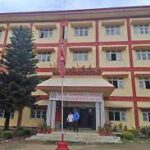Itahari, July 29:
– Birat Anupam
After the first local elections of federal Nepal, Khem Dahal of Chimphang of Menchchyayem Rural Municipality had migrated to Itahari. His new house is in Itahari Sub-Metropolitan City ward number 5 of Sunsari. Previously Dahal had few plots of land in Itahari. He did not have thought of migrating to Itahari. However, after his only son Kabiraj Dahal settled in Australia and he felt aging, he made his mind to migrate to Itahari.
”Years before, migrating to Itahari from Tehrathum was not a good idea as people there feared mosquitoes, baking heat and the not so good water”, said Dahal, ”These days, despite all these previously assumed hurdles in Nepal’s plain Terai, people are migrating en masse.” Dahal was an elected representative during Panchayat era. He has not left his physical properties of land, home and forest in his ancestral hinterland, but also left his social and political capital.
Dahal is not the lone family of the Chimphang village to do so. Many of his immediate family circles and relatives are also doing the same. According to the statistics of Menchchyayem Rural Municipality 43 families of Menchchyayem Rural Municipality ward number 2 to which Chimphang belongs to have migrated outside. The rural municipality statistics shows that 139 family members have migrated outside from the 43 families. Interesting, there is not a single family to migrate to this ward, says the rural municipality statistics.
Binuta Gautam of Morahang village of Menchchyayem Rural Municipality has similar tale. Once a local of the Morahang, she has now turned out to be a tenant of a local homeowner in Morahang Bazar. She has erected her own home in Itahari. Only reason she is not leaving her ancestral village is owing to her teaching job at the local secondary school named Shree Gaukhuri Secondary School of Morahang. Her only son and daughter in law are also living in her village.
That is also owing to their jobs there. ”It is not inner interest to sell our ancestral property in our ancestral village and move out for Terai.
We have love for our ancestral land and property,” said Binuta Gautam. She added, ”Many factors are at play to come to this conclusion.” Binuta Gautam’s official migration to Itahari from Morahang village of Menchchyayem Rural Municipality of Tehrathum is not the standout case. Many of her neighbors and other families of her relative circles have also migrated to various urban centers and parts of eastern Terai like Dharan, Itahari, Biratnagar, Damak, Urlabari, among others. The migration statistics of Menchchyayem Rural Municipality says that 51 families have migrated outside from ward number 5 to which Morahang is also a part of. From the 51 families, 159 family members have migrated outside, says the local government statistics.
Rural Municipality statistics shows rapid outmigration
Chimphang and Morahang are just two examples of the rapid scale of outmigration in the Menchchyayem Rural Municipality which borders Sankhuwasabha and Taplejung districts together with two other local bodies of Tehrathum namely Myanglung Municipality and Phedap Rural Municipality.
According to the IT Officer of the Menchchyayem Rural Municipality Ishor Bhattarai, in the last six years, 244 families from all 6 wards of the rural municipality have migrated outside. These 244 families do have 730 family members as registered in the local government. Out of six wards of the rural municipality, ward number 5 has seen highest level of outmigration. 159 members of 51 families have migrated outside in the last six years from the ward. Other wards with similar trends include ward number 6 where 161 family members of 46 families have migrated outside. Likewise, in ward number 2, the total families to have emigrated outside are 43 which include 139 family members. 43 families with 93 family members have migrated outside from ward number 4. Likewise, 99 family members of 32 families of the ward number 3 have also migrated outside. The least outmigration is in the ward number 1 where 80 family members from 29 families have migrated outside.
This figure, according to local, is the huge figure as the total population of the rural municipality is less than 8000.
There is not good migration trend to come to the rural municipality. For example, just 57 family members of 22 families have arrived in the Menchchyayem Rural Municipality in the last six years since 2074 BS. However, not a single member of any family has arrived in ward number 2. The arrival rate in the three other wards is in single digit. For example, a member of a one-member family has arrived in ward number 1, three member of a family have arrived in ward number 3 and five members of three family have arrived in ward number 5. In ward number 4, 32 family members of 12 families have arrived. In ward number 6, 16 members of five families have arrived.
Still, the statistics is not adequate, say locals. ”This statistics does not include families already migrated but not listed officially and they still do have their padlocked homes in the village”, says Indra Bhattarai, a local of Morahang. He added, ”The migration trend is alarming. All three-tier of governments must device some strong programs to pause it.”
Locals say growing trend of foreign employment, longing for better services in urban centers and lack of strong health facilities have compelled people to migrate outside their ancestral village. ”It is not the choice to migrate outside ancestral village”, said Khem Dahal, who is in his sixties, ”It is the compulsion.”
(RSS)




